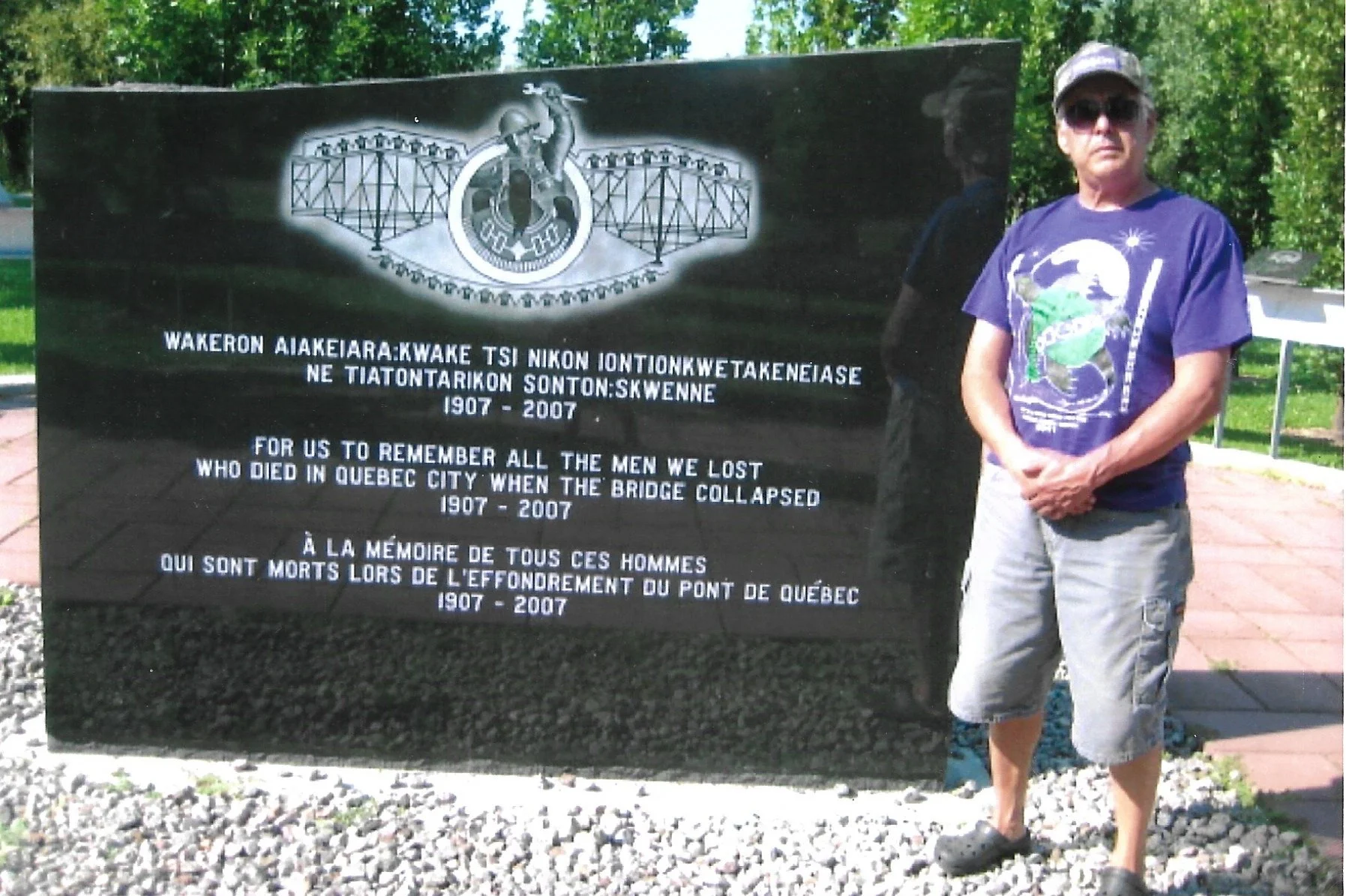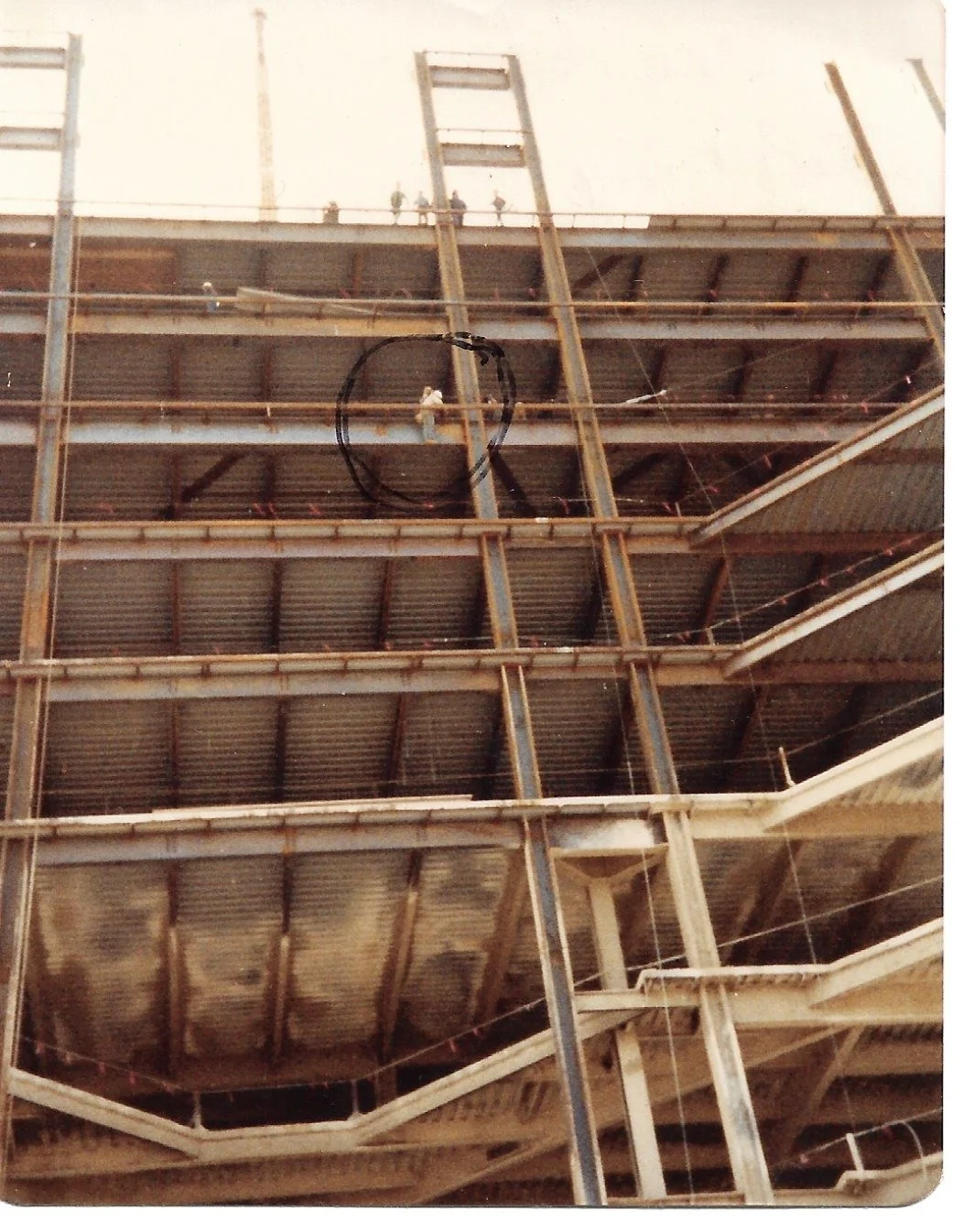Died on the iron
John gives his respects to all of the ironworkers who had lost their lives on from the Quebec Bridge disaster, including his great-great-grandfather. (Courtesy. John Stacey)
Story told by John Stacey
In 1950, my father was working in Boston when he fell off a bridge. At the time, they were putting up the Tobin Bridge, the one that goes over the Mystic River. He came down 80 feet and bounced off the iron. I was two years old, and we went out there by train because he was in the hospital in Boston. For two years, one leg was shorter than the other. He had a hearing aid, and he had a big steel plate in his face. Whenever he would drink beer, his skin would tighten up and you would see the mark of the plate in his cheek. He was off work for five years. That didn’t change anything though because after those five years he went back to work, and while he was on the job he fell off again and that’s what killed him.
My great-great grandfather died on the iron at the Quebec Bridge disaster, my great grandfather died on the iron, and my dad died on the iron. They all fell. I don’t remember my grandfather's name, but I remember that in his pocket was a silver dollar. It was bent at a 90-degree angle, that's how hard he hit.
I came down one floor on a job while I was working at Martin’s Creek in Pennsylvania. I was doing sag rods on the outside of the building. After setting one sag rod, I was walking from one column to the next column to put in the next rod and the wind caught me. My helmet went down 150 feet, and I could see the rebar sticking up, I said to myself, “Not today, John.” I fell on a ballast tank that was sitting on the grating, I was lucky because the floor under that was wide open. It almost got me.
KANIEN’KÉHA VERSION
↓
KANIEN’KÉHA VERSION ↓
Karistà:ke wahrénheie'
Bolting up the Meadowland Stadium in 1980 was all part of the job for John. (Courtesy. John Stacey)
Story told by John Stacey
1950 shitiohserò:ten, Wáston thoió'tehkwe' rake'níha shontahaià:ten'ne' tsi waskóhon. Neh shitkahá:wi', ronskwakétskwaskwe thí:ken Tobin Bridge, né: ki' tsi niká:ien' Mystic River è:neken teioiahià:kon. Sha'té:kon niwahsì:take tahaià:ten'ne' tánon karistà:ke tontahottá:ko'. Tékeni tetewatién:tahkwe', tánon' ehtiio'kéha nia'ákwe' ase'kén Wáston nonkwá:ti tsi iakenheion'taientáhkhwa' then'terón:tahkwe'. Teiohserá:ke na'á:wen', skahsí:na sénha ken' nitiottè:'a tsi ní:ioht nó:ia'. Ionhronkà:tha' rátsthahkwe', tánon' karistowá:nen kara'wistón:ni í:wa' rakónhsakon. Kátke enhahnekì:ra' onen'tákeri, entewastáthen' tsi róhnare' tánon 'eniokèn:ta'ne' tsi nikaierón:ni ne kara'wistón:ni rahnho'kwà:ke. Wísk niiohserá:ke wahatonríshen' tsi roió'te'. Iah othé:nen tha'teioténion thí:ken ase'kén sahoio'ténhsera' ohnà:ken thí:ken wísk niiohserá:ke, tánon' sok á:re' tahaià:ten'ne' tsi roió'te' tánon' nè:'e wahóriohte'.
Né: tékeni teiohsotsherá:ne rakhsótha' wahrénheie' tsi roió'te Quebec shontónskwen'ne', teiohsotsherá:ne rakhsótha' wahrénheie' karistà:ke, sok rake'níha wahrénheie' karistà:ke. Akwé:kon thotiia'tèn:'en. Iah tekè:iahre' nahò:ten' ronwá:iats ne rakhsótha', nek tsi kè:iahre' raohna'tahtsherá:kon wá:tahkwe' kahwistakén:ra ohwísta'. Tióhton niwáhsen niio'kháhake na'teiothsà:kton, tho niio'shátste' na'teiaonkò:'on.
Skaswèn:kara takátsnenhte' tsi watió'te' tsi náhe' Martin's Creek Pennsylvania nonkwá:ti shiwatió'te'. Átste' na'kanónhsati kanonhsahní:rats karón:ware' ontió'ten'. Sha'khnió:ten' skarón:wara, ó:ia' karón:tote' wà:kene' né: ki' nó:ia' akeronwaró:ten' sok ówera' ontié:na'. Énska tewen'niáwe tánon' wísk niwáhsen niwahsì:take tòn:sen'ne' akwanòn:warore', tánon' katkáhthos thí:ken iehnirátstha' karón:ware iottakarà:wen, wa'katathró:ri', "Tóhsa òn:wa wenhniserá:te', Shawátis." Eh è:neken io'arahniròn:ke' ká:ien' kahonwakstéhtha' ka'náhkon ia'tia'tà:ra'ne', onkwatera'swí:ioste' wáhi ase'kén tó:k na'teionaktakà:ron thí:ken nà:kon tkaswen'kará:te'. Saréka aontié:nen.
Edited by: Aaron McComber, Local Journalism Initiative Reporter
Translated by: Karonhí:io Delaronde


